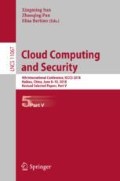Abstract
It is a fast and simple way to run a Delay Tolerant Network (DTN) by mobile terminals in an urban environment, therefore DTN currently plays an important role as a network for Internet of Things (IoT). The network metrics are important for performance of DTN based communication systems. Because moving characteristics in urban environments are different from other challenging network environments, then the routing method is also different in various environments. In general, routing algorithm decides the DTN performance, so it cannot release potential performance with traditional routing algorithms in cities. In this paper, we propose a routing algorithm for urban areas, named Forward Routing based Distance Variation (FRDV), and we designed such approach according to human moving characteristics. FRDV comprises two stages which include selecting relay node and messages transmission decision. At the first stage, FRDV select a relay node depend on sending activity which depends on delivery frequency of nodes. During the short encounter time, the nodes selectively sent messages to the relay node based on moving status of nodes at the second stage. The simulation results suggest that FRDV outperforms than classical algorithms such as Epidemic, Prophet, Direct Delivery and First Contact algorithms in urban environments.
Access this chapter
Tax calculation will be finalised at checkout
Purchases are for personal use only
References
Silva, A.P.F., et al.: Congestion control in disruption-tolerant networks: a comparative study for interplanetary and terrestrial networking applications. Ad Hoc Netw. 44(1), 1–18 (2016)
Srihari, B.F., Naidu, S.K., Nirupama, T.P.: Protect knowledge retrieval for localized disruption tolerant military networks. Int. J. Comput. Trends Technol. (IJCTT) 24(3), 108–112 (2015)
Rajpoot, N., Kushwahr, R.S.: An efficient technique for underwater communication using opportunistic routing protocol. In: International Conference on Next Generation Computing Technologies. Dehradun, India, 4–5 September, pp. 251–256 (2015)
He, Y.F., et al.: Smart city. Int. J. Distrib. Sens. Netw. (2014)
Wu, Y., Deng, S., Huang, H.: Performance analysis of hop-limited epidemic routing in DTN with limited forwarding times. Int. J. Commun. Syst. 28(15), 2035–2050 (2015)
Shinko, I., et al.: A simulation system based on ONE and SUMO simulators: performance evaluation of first contact, prophet and spray-and-wait DTN protocols. In: International Conference on Broadband and Wireless Computing, Communication and Applications, Krakow, Poland, 4–6 November, pp. 137–142 (2015)
Zhu, Y., et al.: Social based throw box placement schemes for large-scale mobile social delay tolerant networks. Comput. Commun. 65(1), 10–26 (2015)
Murillo, M.J., Aukin, M.: Application of wireless sensor nodes to a delay-tolerant health and environmental data communication system in remote communities. In: Global Humanitarian Technology Conference (GHTC). Seattle, WA, US, 30 October, pp. 383–392 (2011)
Yanggratoke, R., et al.: Delay tolerant network on android phones: implementation issues and performance measurements. J. Commun. 6(6), 477–484 (2011)
Ekman,F., et al.: Working day movement model. In Proceedings of the 1st ACM SIGMOBILE Workshop on Mobility models. ACM (2008)
Papandrea, M., et al.: On the properties of human mobility. Comput. Commun. 87(1), 19–36 (2016)
Spanakis, E.G., Voyiatzis, A.G..: DAPHNE: a disruption-tolerant application proxy for e-health network environments. In: International Conference on Wireless Mobile Communication and Healthcare, pp. 88–95 (2012)
Spyropoulos, T., Psounis, K., Raghavendra, C.S.: Single-copy routing in intermittently connected mobile networks. In: 2004 First Annual IEEE Communications Society Conference on Sensor and Ad Hoc Communications and Networks, IEEE SECON 2004, pp. 235–244 (2004)
Wang, T., Cao, Y., Zhou, Y., et al.: A survey on geographic routing protocols in Delay/Disruption Tolerant Networks (DTNs). Int. J. Distrib. Sens. Netw., 1–12 (2016)
Li, W.-Z., et al.: DTN routing with fixed stations based on the geographic grid approach in an urban environment. Wireless Pers. Commun. 82(4), 2033–2049 (2015)
Chaintreau, A., et al.: Impact of human mobility on opportunistic forwarding algorithms. IEEE Trans. Mobile Comput. 6(6), 606–620 (2007)
Rachman, Z.A., Maharani, W.: The analysis and implementation of degree centrality in weighted graph in Social Network Analysis, pp. 72–76 (2013)
Lindgren, A., Doria, A., Schelén, O.: Probabilistic routing in intermittently connected networks. SIGMOBILE Mob. Comput. Commun. Rev. 7(3), 19–20 (2003)
Keränen, A., Ott, J., Kärkkäinen, T.: The ONE simulator for DTN protocol evaluation. In: Proceedings of the 2nd international conference on simulation tools and techniques. ICST (Institute for Computer Sciences, Social-Informatics and Telecommunications Engineering), p. 55 (2009)
Acknowledgments
This research was supported in part by National Nature Science Foundation of China (No. 61401047), National Natural Science Foundation of China under Grants (No. 41404102), in part by the Sichuan Youth Science and Technology Foundation under Grant (No. 2016JQ0012), in part by the Key Project of Sichuan provincial Education Department (No. 16ZA0218), the 2015 Annual Young Academic Leaders Scientific Research Foundation of CUIT (No. J201506), Science and Technology Department of Sichuan Province, Fund of Science and Technology Planning (No. 2018JY0290). The authors also thank for the supporting of SINOPEC Key Laboratory of Geophysics and Graphic & image Collaborative Innovation Center of CUIT.
Author information
Authors and Affiliations
Corresponding author
Editor information
Editors and Affiliations
Rights and permissions
Copyright information
© 2018 Springer Nature Switzerland AG
About this paper
Cite this paper
Li, W. et al. (2018). FRDV: A DTN Routing Based on Human Moving Status in Urban Environments. In: Sun, X., Pan, Z., Bertino, E. (eds) Cloud Computing and Security. ICCCS 2018. Lecture Notes in Computer Science(), vol 11067. Springer, Cham. https://doi.org/10.1007/978-3-030-00018-9_31
Download citation
DOI: https://doi.org/10.1007/978-3-030-00018-9_31
Published:
Publisher Name: Springer, Cham
Print ISBN: 978-3-030-00017-2
Online ISBN: 978-3-030-00018-9
eBook Packages: Computer ScienceComputer Science (R0)

